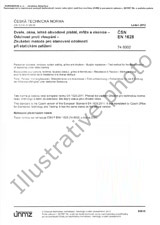We need your consent to use the individual data so that you can see information about your interests, among other things. Click "OK" to give your consent.
ČSN EN 61189-5-4 (359039)
Test methods for electrical materials, printed boards and other interconnection structures and assemblies - Part 5-4: General test methods for materials and assemblies - Solder alloys and fluxed and non-fluxed solid wire for printed board assemblies
Automatically translated name:
Test methods for electrical materials , printed boards and other interconnection structures and assemblies - Part 5-4: General test methods for materials and assembly - the solder alloy and solder wire with a solid core and core tavidlovým for manned plate ( standard for direct use as CSN ).
STANDARD published on 1.8.2015
The information about the standard:
Designation standards: ČSN EN 61189-5-4
Classification mark: 359039
Catalog number: 97493
Publication date standards: 1.8.2015
SKU: NS-612043
The number of pages: 32
Approximate weight : 96 g (0.21 lbs)
Country: Czech technical standard
Category: Technical standards ČSN
The category - similar standards:
Annotation of standard text ČSN EN 61189-5-4 (359039):
relates to test methods for materials or component robustness for printed board assemblies, irrespective of their method of manufacture.
The standard is divided into separate parts, covering information for the designer and the test methodology engineer or technician. Each part has a specific focus; methods are grouped according to their application and numbered sequentially as they are developed and released.
In some instances test methods developed by other TCs (for example, TC 104) have been reproduced from existing IEC standards in order to provide the reader with a comprehensive set of test methods. When this situation occurs, it will be noted on the specific test method; if the test method is reproduced with minor revisions, those paragraphs that are different are identified.
This part of IEC 61189 contains test methods for evaluating robustness of materials or component for printed board assemblies. The methods are self-contained, with sufficient detail and description so as to achieve uniformity and reproducibility in the procedures and test methodologies.
The tests shown in this standard are grouped according to the following principles:
P: preparation/conditioning methods
V: visual test methods
D: dimensional test methods
C: chemical test methods
M: mechanical test methods
E: electrical test methods
N: environmental test methods
X: miscellaneous test methods
To facilitate reference to the tests, to retain consistency of presentation, and to provide for future expansion, each test is identified by a number (assigned sequentially) added to the prefix (group code) letter showing the group to which the test method belongs.
The test method numbers have no significance with respect to an eventual test sequence; that responsibility rests with the relevant specification that calls for the method being performed. The relevant specification, in most instances, also describes pass/fail criteria.
The letter and number combinations are for reference purposes to be used by the relevant specification. Thus "5-4C01" represents the first chemical test method described in IEC 61189-5-4.
In short, in this example, 5-4 is the number of the part of IEC 61189, C is the group of methods, and 01 is the test number.
This part of IEC 61189 focuses on test methods for solder alloys, fluxed and non-fluxed solid wire, based on existing IEC 61189-5 and IEC 61189-6. In addition, it includes test methods for solder alloys, fluxed and non-fluxed solid wire, and for lead free soldering
Preview of the standard ČSN EN 61189-5-4 (359039)
Similar standards:
1.8.2015
1.5.2007
1.12.2013
WITHDRAWN
1.8.1999
WITHDRAWN
1.1.2014
WITHDRAWN
1.10.1999



 Cookies
Cookies
